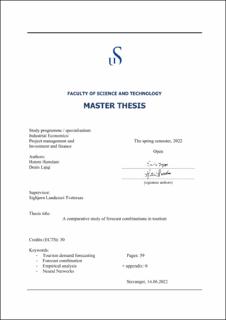| dc.description.abstract | With the rapid expansion of the tourist sector in many nations, tourism forecasting has piqued the interest of marketers and academic researchers. Despite that interest, necessary knowledge about tourism forecasting is still lacking. This study addresses crucial questions to better understand the mechanisms underlying forecasting in tourism. In the present study, we investigate whether forecasting performance could be improved by merging tourism forecasts given by two different models: LF and PMI. The investigation measures forecasting of two different metrics over four distinct lead periods. Two error measures are employed to assess forecast accuracy: the mean absolute percentage error and the mean squared error.
To combine the forecasts, we used four established methods, i.e. The simple average method (SA), the geometric mean method (GEOM), the inverse of the mean squared forecast error method (INVM), and ultimately the variance-covariance method (VACO). Our results show remarkable consistency. For the first metric, the combination of forecasts ranks between the two single model forecasts for both error measures. The findings of the other metric reveal that the forecast combination gives the most accurate forecast.
In addition to the four different weighting methods, this study proposes a method of combining forecasts using neural networking. This latter approach shows results that differs from the other four methodologies. The neural networks reveal inconsistent and erroneous results when the mean absolute percentage error is used to rank forecast accuracy. However, when using the mean squared error, the approach rates first out of all the other methods for all lead times.
Altogether, we demonstrate that combining two reasonably accurate forecasts decreases forecast error. Across all forecasting horizons, the combined forecast is much more accurate than the worst single model forecast. Furthermore, the results reveal that when two relatively accurate forecasts are merged, as with metric 2 in the current study, the combined forecast has more minor errors than both single forecasts. The findings indicate that a forecast combination in tourism might yield positive outcomes. | |
